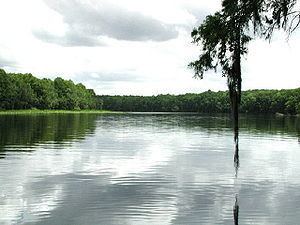- elevation 0 ft (0 m) | Length 396 km | |
 | ||
- right Alapaha River, Withlacoochee River Similar Ichetucknee Springs State Park, Chattahoochee River, St Johns River, Stephen Foster Folk Culture C, Fanning Springs State Park | ||
America s most haunted the ghost boy of the suwannee river
The Suwannee River (also spelled Suwanee River) is a major river that runs through South Georgia southward into Florida in the southern United States. It is a wild blackwater river, about 246 miles (396 km) long. The Suwannee River is the site of the prehistoric Suwanee Straits which separated peninsular Florida from the panhandle.
Contents
- America s most haunted the ghost boy of the suwannee river
- Map of Suwannee River United States
- 2011 suwannee river cruise
- Geography
- Etymology
- History
- Music
- Recreation
- References
Map of Suwannee River, United States
2011 suwannee river cruise
Geography
The headwaters of the Suwanee River are in the Okefenokee Swamp in the town of Fargo, Georgia. The river runs southwestward into the Florida Panhandle, then drops in elevation through limestone layers into a rare Florida whitewater rapid. Past the rapid, the Suwanee turns west near the town of White Springs, Florida, then connects to the confluences of the Alapaha River and Withlacoochee River.
Starting at the confluences of those three rivers, that confluence forms the southern borderline of Hamilton County, Florida. The Suwanee then bends southward near the town of Ellaville, Florida followed by Luraville, Florida then joins together with the Santa Fe River (Florida) from the east south of the town of Branford, Florida.
The river ends and drains into the Gulf of Mexico on the outskirts of Suwannee, Florida.
Etymology
The Spanish recorded the native Timucua name of Guacara for the river that would later become known as the Suwannee. Different etymologies have been suggested for the modern name.
History
The Suwannee River area has been inhabited by humans for thousands of years. During the first millennium CE, it was inhabited by the people of the Weedon Island archaeological culture, and around 900 CE, a derivative local culture, known as the Suwanee River Valley culture, developed.
By the 16th century, the river was inhabited by two closely related Timucua language-speaking peoples: the Yustaga, who lived on the west side of the river; and the Northern Utina, who lived on the east side. By 1633, the Spanish had established the missions of San Juan de Guacara, San Francisco de Chuaquin, and San Augustin de Urihica along the Suwannee to convert these western Timucua peoples.
In the 18th century, Seminoles lived by the river.
The steamboat Madison operated on the river before the Civil War, and the sulphur springs at White Springs became popular as a health resort, with 14 hotels in operation in the late 19th century.
Music
This river is the subject of the Stephen Foster song "Old Folks at Home", in which he calls it the Swanee Ribber. Foster had named the Pedee River of South Carolina in his first lyrics. It has been called Swanee River because Foster had used an alternative contemporary spelling of the name. Foster never actually saw the river he made world-famous.
George Gershwin's song, with lyrics by Irving Caesar, and made popular by Al Jolson, is also spelled "Swanee" and boasts that "the folks up North will see me no more when I get to that Swanee shore".
Both of these songs feature banjo-strumming and reminiscences of a plantation life more typical of 19th-century South Carolina than of among the swamps and small farms in the coastal plain of south Georgia and north Florida.
Don Ameche starred as Foster in the fictional biographical film Swanee River (1939).
When approaching the Suwannee River via several major highways, motorists are greeted with a sign which announces they are crossing the Historic Suwannee River, complete with the first line of sheet music from "Old Folks at Home". This is Florida's state song, designated as such in 1935.
In 2008, its original lyrics were replaced with a politically correct version. There is a Foster museum and carillon tower at Stephen Foster Folk Culture Center State Park in White Springs. The spring itself is called White Sulphur Springs because of its high sulphur content. Since there was a belief in the healing qualities of its waters, the Springs were long popular as a health resort.
The idiom "up the Swannee" or "down the swanny" means something is going badly wrong, analogous to "up the creek without a paddle".
Recreation
A unique aspect of the Suwannee River is the Suwannee River Wilderness Trail, a cooperative effort by the Florida Department of Environmental Protection, the Suwannee River Water Management District, and the cities, businesses, and citizens of the eight-county Suwannee River Basin region. The boating route encompasses 170 river miles (274 river kilometers), from Stephen Foster Folk Culture Center State Park to the Gulf of Mexico.
The Florida National Scenic Trail runs along the Suwannee River's western banks for approximately 60 miles (97 km), from Deep Creek Conservation Area in Columbia County to Twin Rivers State Forest in Madison County.
The Lower Suwannee National Wildlife Refuge offers bird and wildlife observation, wildlife photography, fishing, canoeing, hunting, and interpretive walks. A driving tour is under construction, and several boardwalks and observation towers offer views of wildlife and habitat.
In recent years, the Suwannee River has been the site of many music gatherings. Magnolia Festival, SpringFest, and Wanee have been held annually in Live Oak, Florida, at the Spirit of the Suwannee Music Park, adjacent to the river. Performing artists have included Vassar Clements, Peter Rowan, David Grisman, Allman Brothers Band, and the String Cheese Incident.
